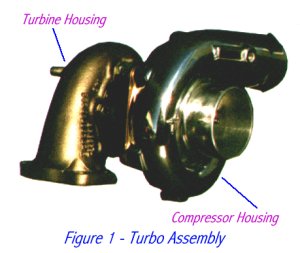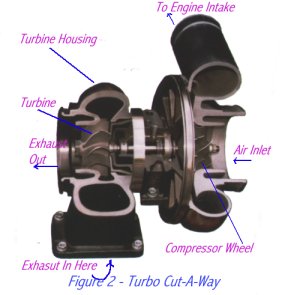Turbocharging
vs. Supercharging
By: Toma Kicovic,
B.Sc.
Lately there has been a lot of BS floating
around on this subject, and a lot of people seem to be confused on the basic
principles of the two systems.
I will be comparing the centrifugal type
of superchargers to the turbo system. Centrifugal blowers are very efficient in
their functioning, and I will discuss what this efficiency means. Centrifugal
superchargers include compressors marketed under such names as Vortech, Paxton,
Powerdyne, ATI, etc...
What Turbos and Supercharger Have in Common
 What is in
common, is that both systems use a centrifugal compressor section to compress
the incoming air to higher than atmospheric pressures. Normal or standard
atmospheric pressure is about 14.7 psi (pounds per square inch). The job of the
compressor is to increase this pressure so that more oxygen content (air) is
available to fill the cylinders. This is really not a very technical
explanation, but is meant to be quite general.
What is in
common, is that both systems use a centrifugal compressor section to compress
the incoming air to higher than atmospheric pressures. Normal or standard
atmospheric pressure is about 14.7 psi (pounds per square inch). The job of the
compressor is to increase this pressure so that more oxygen content (air) is
available to fill the cylinders. This is really not a very technical
explanation, but is meant to be quite general.
Both systems offer very good efficiency.
When properly matched to the air flow characteristics of the motor, efficiencies
in the 70 and 80% range can be had. When you compress a gas, its temperature
will increase, so effciency is basically how much heat is introduced compared to
the level of compression (the less heat, the higher the efficiency). I won't get
more technical than that, but 75% is generally considered very efficient (as a
comparison, old style roots blowers were only about 50% efficient).
Both Turbos and Superchargers require high
rpm of their impellers (compressors) to achieve a given boost level. This rpm
ranges from 30,000-65,000 in superchargers and can be even higher with turbos
(over 100,000!).
What is Different
 The major difference is in the drive
system of the 2 systems. A turbocharger's compressor section is connected
directly by a shaft to the turbine housing. The turbine is the portion of the
turbo that takes exhaust energy (heat and pressure) and converts it to motion.
Since the turbine and the compressor are connected by a shaft, the compressor
spins at the same rate as the turbine.
The major difference is in the drive
system of the 2 systems. A turbocharger's compressor section is connected
directly by a shaft to the turbine housing. The turbine is the portion of the
turbo that takes exhaust energy (heat and pressure) and converts it to motion.
Since the turbine and the compressor are connected by a shaft, the compressor
spins at the same rate as the turbine.
On a supercharger, the compressor section
is connected to a step up mechanism (gears, belts, pulleys or whatever) and then
to the engine drive belt. The step up mechanism is required to convert the 6000
(or so) engine rpm, to the 40,000+ rpm necessary to build boost.
Centrifugal compressors build boost as rpm
increases in close to an exponential fashion. Turbo's come up to speed very
quickly (almost instantly if properly sized), and once a desired boost level is
reached, excess exhaust gas is bypassed around the turbine by a 'waste gate'.
What this does is limit the speed of the compressor (and turbine) and therefore
boost. The point where the waste gate opens can be set so as to produce a
desired rpm and boost level. With a turbo then, as soon as there is sufficient
exhaust flow, the turbine will come to speed, and you can have full boost within
a fraction of a second. A properly sized turbo can achieve its maximum boost
setting at almost any rpm you desire, on a 6000rpm motor, this can be as low as
about 2500rpm.
A supercharger on the other hand relies
on engine rpm to come up to speed, so maximum boost wont 'come on' until higher
rpm. If you buy a supercharger marketed as an 8psi kit, that generally is the
maximum boost on a stock engine. But due to it exponential nature, boost will
quickly drop with rpm. If your kit makes 8 psi at 6000 rpm, it will generally
make less than 2.5 psi at 3000rpm.
Performance Differences
So far we have seen that due to the nature of the
centrifugal compressor design, a turbo will reach its target boost level much
quicker than a belt driven supercharger. Are there any other differences?
It takes power to pump (compress) a large
volume of air (700+cfm). The supercharger's power is derived directly from the
crank shaft, where as a turbo's power comes from energy contained in the exhaust
gasses. On a typical 8 psi supercharger, the power used can be in the
neighborhood of 40-60hp! On a 1500hp engine, the power used by the supercharger
can be as much as 300hp! This would leave only 1200hp to accelerate the
car.
A turbo is not entirely 'free' horsepower
as some additional back pressure is created by the turbine, but a turbo derives
a very large portion of its energy from heat. This is shown by the fact that
exhaust gas temperature can drop by as much as 300 degrees Fahrenheit as it
leaves the turbine housing. In essence the power 'robbed' by the extra back
pressure is very small (also due to other more 'complicated' factors like
critical exhaust flow, but we wont get into that here).
So what does this all mean? Basically an 8
psi turbo kit will produce more peak power due to the fact that a supercharger
is using a fairly large amount of power just to get it spinning. What is more
important for a street car is 'power under the curve' meaning the average
horsepower produced. This is where the turbo really shines since you can have
full boost at as little as 2500 rpm! This will make the turbo car feel like it
has 50% more cubic inches (or more). The difference in torque at low rpm's can
be as much as 100 lb ft in favor of the turbo due to the additional available
boost....now that's performance!
Who Makes a Good Turbo Kit and Is It Complicated or Expensive?
Several manufacturers offer good turbo systems. The
one I chose for my Mustang was manufactured by INCON Systems. Two other manufacturers
who's kits work well are the ones from Cartech and TurboTechnology.
The INCON kit is hands
down the best "street" kit I have ever seen (capable of over 800hp!),
however, I am not sure if INCON is even in business any more. There are occasionaly
used INCON kits on ebay, and often older DDMI kits are passed off as Incon kits,
even though there are some HUGE differences....buyer beware!
The "Home Made" route
is also a great way to go for the DIY'ers. Many people have gone this route,
and if you are handy, can weld, and are willing to do a lot of swearing, you
may opt for this method. Common turbos used are T3's from early Tbirds, Mustangs
etc, some diesel turbos etc... A great place to learn and ask question is on
the Yahoo Groups sites.... JYTurbo (junkyard turbo) is http://groups.yahoo.com/group/jyturbo/
and another good one is the "BlowThru" list (people who run carburetors
with their turbos) http://groups.yahoo.com/group/BLOWTHRU/
. There are a fe other links on my personal turbo page at http://www.members.tripod.com/tomak3/page5.html
.
After Thoughts
I originally wrote this article
a few years ago, and have seen it referenced several times since....kinda flattering.
I have not chnaged it very much as the basic concepts still apply. I love both
turbos and superchargesr, and even big blocks on nitrous ;). My honest opinion
is that a turbo set-up will outperform a supercharger set-up, however, for the
begginer, the supercharger is a simpler and more user friendly system.
I have done quite a bit of research
on the subject and have read several books on it as well (Maximum Boost - Corky
Bell, Turbocharging - Hugh MacInnes, Street Supercharging - Pat Ganahl, Performance
With Economy - David Vizard, 21st Century Performance - Julian Edgar)). I was
always fascinated by how an Indy car with less than 100 cubic inch turbo engine
could make over 1000hp, or how some of the 4 litre Turbo Buicks could make 1000+hp.
What impressed me the most was how docile some of the high horsepower turbo
cars were (mainly due to the smaller cams). The fact that turbos are banned
and have been banned in many classes of racing also illustrates their effectiveness....other
competitors are scared of them! When Hurley Bleakeny set the door slammer mph
speed record several years ago in his T bird, it was with a turbo motor.
I also once owned a
2.3 litre turbo Merkur Xr4Ti, and was VERY impressed how with only bigger
exhaust and hand ported intake and more boost, the car could easily beat stock
V8 cars (Mustangs, Corvettes etc...). It also had a top speed of 240 km/h, which
was limited by gearing NOT by power. This car was not even
intercooled.
After my experience
with the Paxton supercharger on my first Mustang, I really wanted to build my
own turbo kit (due to lack of bottom end torque), but was limited in my abilities
and finances at the time and the result was the 460 big block conversion in
the black car. Also after the Powerdyne car, I again had my 'flame' re-sparked,
and decided to go for it. I actually had 1 turbo from a Tbrid and a line on
2 intercoolers from Toyota Supras. That was when I heard about INCON and their
kit, and decided to forgo months of fabrication and experimentation and buy
a complete, ready to bolt on kit.

Questions? Email me!
BACK
TO HOME
 What is in
common, is that both systems use a centrifugal compressor section to compress
the incoming air to higher than atmospheric pressures. Normal or standard
atmospheric pressure is about 14.7 psi (pounds per square inch). The job of the
compressor is to increase this pressure so that more oxygen content (air) is
available to fill the cylinders. This is really not a very technical
explanation, but is meant to be quite general.
What is in
common, is that both systems use a centrifugal compressor section to compress
the incoming air to higher than atmospheric pressures. Normal or standard
atmospheric pressure is about 14.7 psi (pounds per square inch). The job of the
compressor is to increase this pressure so that more oxygen content (air) is
available to fill the cylinders. This is really not a very technical
explanation, but is meant to be quite general.
 The major difference is in the drive
system of the 2 systems. A turbocharger's compressor section is connected
directly by a shaft to the turbine housing. The turbine is the portion of the
turbo that takes exhaust energy (heat and pressure) and converts it to motion.
Since the turbine and the compressor are connected by a shaft, the compressor
spins at the same rate as the turbine.
The major difference is in the drive
system of the 2 systems. A turbocharger's compressor section is connected
directly by a shaft to the turbine housing. The turbine is the portion of the
turbo that takes exhaust energy (heat and pressure) and converts it to motion.
Since the turbine and the compressor are connected by a shaft, the compressor
spins at the same rate as the turbine.
